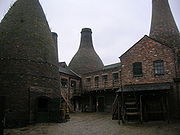
Gladstone Pottery Museum
Encyclopedia
jul2004.jpg)

Pottery
Pottery is the material from which the potteryware is made, of which major types include earthenware, stoneware and porcelain. The place where such wares are made is also called a pottery . Pottery also refers to the art or craft of the potter or the manufacture of pottery...
, typical of those once common in the North Staffordshire
Staffordshire
Staffordshire is a landlocked county in the West Midlands region of England. For Eurostat purposes, the county is a NUTS 3 region and is one of four counties or unitary districts that comprise the "Shropshire and Staffordshire" NUTS 2 region. Part of the National Forest lies within its borders...
area of England from the time of the industrial revolution
Industrial Revolution
The Industrial Revolution was a period from the 18th to the 19th century where major changes in agriculture, manufacturing, mining, transportation, and technology had a profound effect on the social, economic and cultural conditions of the times...
in the 18th century to the mid 20th century.
It is located in Longton
Longton, Staffordshire
Longton is a southern district of Stoke-on-Trent, Staffordshire, England, and is known locally as the "Neck End" of the city. Longton is one of the six towns of "the Potteries" which formed the City of Stoke-on-Trent in 1925.-History:...
, Staffordshire
Staffordshire
Staffordshire is a landlocked county in the West Midlands region of England. For Eurostat purposes, the county is a NUTS 3 region and is one of four counties or unitary districts that comprise the "Shropshire and Staffordshire" NUTS 2 region. Part of the National Forest lies within its borders...
.
It is an Anchor Point of ERIH, The European Route of Industrial Heritage
European Route of Industrial Heritage
The European Route of Industrial Heritage is a network of the most important industrial heritage sites in Europe. The aim of the project is to create interest for the common European Heritage of the Industrialisation and its remains...
.
History of Museum
A pottery factory first opened on the site in 1787.The factory opened as a museum in 1974, the buildings having been saved from demolition in 1970 when the pottery closed (some ten years after its bottle oven
Bottle oven
A bottle oven is a type of kiln. The word 'bottle' refers to the shape of the structure and not to the kiln's products which were pottery not glass....
s were last fired).
The museum has shown its commitment to industrial heritage
Industrial heritage
Industrial heritage is an aspect of cultural heritage dealing specifically with the buildings and artifacts of industry which are inherited from past generations, maintained in the present and bestowed for the benefit of future generations, often forming a significant attraction for tourism.The...
by continuing to function as a working pottery, but production has had to be curtailed for financial reasons.
There is a varied range of ceramics on display, not only mass-produced pottery but also art pottery such as the "Gladstone Vase" by Frederick Alfred Rhead
Frederick Alfred Rhead
Frederick Alfred Rhead was a potter working in North Staffordshire, England. He is not to be confused with his son Frederick Hurten Rhead who was also a potter, and who worked mainly in the USA. His other children included the pottery designer Charlotte Rhead.Rhead's father, G.W...
.
Each year, the museum holds seasonal events - the most popular being the annual Christmas Carol Festival/Concert and the Halloween night. Visitors are lead around the bottle kilns and factory rooms by a guide who relays tales of yesteryear.
Archives from the domesday book indicate that a pot bank may have indeed been in existence on the Gladstone site since the mid-11th century at around the time of the battle of Hastings (or the Battle of Battle) as it should perhaps be correctly named.
Media Interest
Gladstone has seen its share of celebrity interest, from Tony RobinsonTony Robinson
Tony Robinson is an English actor, comedian, author, broadcaster and political campaigner. He is best known for playing Baldrick in the BBC television series Blackadder, and for hosting Channel 4 programmes such as Time Team and The Worst Jobs in History. Robinson is a member of the Labour Party...
filming for a BBC documentary 'The Worst Jobs in Britain' and from Alan Titchmarsh
Alan Titchmarsh
Alan Fred Titchmarsh, MBE DL is an English gardener, broadcaster and novelist. After working as a professional gardener and a garden journalist, he established himself as a media personality through appearances on gardening programmes...
. It also has regular visits from the Blue Peter
Blue Peter
Blue Peter is the world's longest-running children's television show, having first aired in 1958. It is shown on CBBC, both in its BBC One programming block and on the CBBC channel. During its history there have been many presenters, often consisting of two women and two men at a time...
crew, and numerous children's TV programmes. In the early 1990s it was featured on Noel's Houseparty with a live 'gunging' outside of the bottle kilns. The Doctor Who
Doctor Who
Doctor Who is a British science fiction television programme produced by the BBC. The programme depicts the adventures of a time-travelling humanoid alien known as the Doctor who explores the universe in a sentient time machine called the TARDIS that flies through time and space, whose exterior...
serial The Ultimate Foe
The Ultimate Foe
The Ultimate Foe is the generally accepted title for a serial in the British science fiction television series Doctor Who, which was first broadcast in two weekly parts from 29 November to 6 December 1986. It is part of the larger narrative known as The Trial of a Time Lord, encompassing the whole...
was filmed at the museum.
Gladstone pottery museum was featured on Living TV's popular series, "Most Haunted". Known as a site of paranormal activity, Gladstone has seen a recent surge in amateur and professional paranormal groups/mediums visiting the museum. The current Operations Manager, Ian Watson was featured on the programme.

